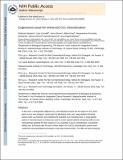| dc.contributor.author | Barbero, Roberto Juan | |
| dc.contributor.author | Carnelli, Lino | |
| dc.contributor.author | Simon, Anna | |
| dc.contributor.author | Kao, Albert | |
| dc.contributor.author | Monforte, Alessandra d'Arminio | |
| dc.contributor.author | Riccò, Moreno | |
| dc.contributor.author | Bianchi, Daniele | |
| dc.contributor.author | Belcher, Angela M | |
| dc.date.accessioned | 2014-11-19T19:22:54Z | |
| dc.date.available | 2014-11-19T19:22:54Z | |
| dc.date.issued | 2013 | |
| dc.date.submitted | 2012-03 | |
| dc.identifier.issn | 1754-5692 | |
| dc.identifier.issn | 1754-5706 | |
| dc.identifier.uri | http://hdl.handle.net/1721.1/91613 | |
| dc.description.abstract | In this work, a biologically catalysed CO2 mineralization process for the capture of CO2 from point sources was designed, constructed at a laboratory scale, and, using standard chemical process scale-up protocols, was modelled and evaluated at an industrial scale. A yeast display system in Saccharomyces cerevisae was used to screen several carbonic anhydrase isoforms and mineralization peptides for their impact on CO2 hydration, CaCO3 mineralization, and particle settling rate. Enhanced rates for each of these steps in the CaCO3 mineralization process were confirmed using quantitative techniques in lab-scale measurements. The effect of these enhanced rates on the CO2 capture cost in an industrial scale CO2 mineralization process using coal fly ash as the CaO source was evaluated. The model predicts a process using bCA2-yeast and fly ash is [similar]10% more cost effective per tonne of CO2 captured than a process with no biological molecules, a savings not realized by wild-type yeast and high-temperature stable recombinant CA2 alone or in combination. The levelized cost of electricity for a power plant using this process was calculated and scenarios in which this process compares favourably to CO2 capture by MEA absorption process are presented. | en_US |
| dc.description.sponsorship | MIT Energy Initiative | en_US |
| dc.description.sponsorship | Eni S.p.A. (Firm) | en_US |
| dc.description.sponsorship | National Institutes of Health (U.S.) (NIH Biotechnology Training Program) | en_US |
| dc.description.sponsorship | Thomas and Stacey Siebel Foundation | en_US |
| dc.language.iso | en_US | |
| dc.publisher | Royal Society of Chemistry | en_US |
| dc.relation.isversionof | http://dx.doi.org/10.1039/c2ee24060b | en_US |
| dc.rights | Creative Commons Attribution-Noncommercial-Share Alike | en_US |
| dc.rights.uri | http://creativecommons.org/licenses/by-nc-sa/4.0/ | en_US |
| dc.source | PMC | en_US |
| dc.title | Engineered yeast for enhanced CO2 mineralization | en_US |
| dc.type | Article | en_US |
| dc.identifier.citation | Barbero, Roberto, Lino Carnelli, Anna Simon, Albert Kao, Alessandra d’Arminio Monforte, Moreno Riccò, Daniele Bianchi, and Angela Belcher. “Engineered Yeast for Enhanced CO2 Mineralization.” Energy & Environmental Science 6, no. 2 (2013): 660. | en_US |
| dc.contributor.department | Massachusetts Institute of Technology. Department of Biological Engineering | en_US |
| dc.contributor.department | Massachusetts Institute of Technology. Department of Materials Science and Engineering | en_US |
| dc.contributor.department | Koch Institute for Integrative Cancer Research at MIT | en_US |
| dc.contributor.mitauthor | Barbero, Roberto Juan | en_US |
| dc.contributor.mitauthor | Belcher, Angela M. | en_US |
| dc.relation.journal | Energy & Environmental Science | en_US |
| dc.eprint.version | Author's final manuscript | en_US |
| dc.type.uri | http://purl.org/eprint/type/JournalArticle | en_US |
| eprint.status | http://purl.org/eprint/status/PeerReviewed | en_US |
| dspace.orderedauthors | Barbero, Roberto; Carnelli, Lino; Simon, Anna; Kao, Albert; Monforte, Alessandra d'Arminio; Riccò, Moreno; Bianchi, Daniele; Belcher, Angela | en_US |
| dc.identifier.orcid | https://orcid.org/0000-0001-9353-7453 | |
| mit.license | OPEN_ACCESS_POLICY | en_US |
| mit.metadata.status | Complete | |
